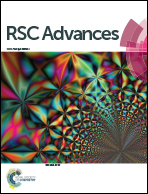Global calibration model of UV-Vis spectroscopy for COD estimation in the effluent of rural sewage treatment facilities†
Abstract
In recent years, rural sewage treatment facilities have grown rapidly in China, and yet the water quality of the effluent has not been well monitored. The detection of chemical oxygen demand (COD) via ultraviolet-visible (UV-Vis) spectroscopy is an emerging technology with advantages of low cost and easy maintenance, which make it appropriate for the on-line monitoring of effluents from rural sewage treatment facilities. Because there are numerous sewage treatment devices in rural regions and as their locations are usually very scattered, it is difficult to calibrate the COD estimation model for each monitoring site. Hence, a COD estimation model with global calibration is a specific problem for application in rural regions. However, little research was performed on real rural sewage, yet much is desired in terms of the model accuracy and robustness. Consequently, a practical COD detection method with UV-Vis spectroscopy was established in this study. The COD estimation model was globally calibrated with effluents from rural sewage treatment devices. In order to avoid misleading data for evaluating the model performance caused by the differences in the COD concentration range of training sets, two new criteria, namely the Root Mean Square Relative Error (RMSRE) and Relative Error Variance (REV), were proposed to evaluate the model accuracy and robustness. Differences in the organic composition as characterized by excitation–emission matrix (EEM) fluorescence spectroscopy were shown to significantly affect the accuracy of the global calibration model. Through comparison among the methods of the partial least squares (PLS), support vector machine (SVM), and back-propagation neural network, PLS was verified to be able to attain sufficient accuracy and to be suitable for applying to the modeling with global calibration. A simplified modeling method was proposed to replace the absorption spectra at the full wavelength band with the absorbance at some specific wavelengths that were selected by interval partial least-squares regression (iPLSR) and synergy interval partial least-squares regression (siPLSR). In this study, the simplified model was proven to be reliable with three specific wavelengths: 251, 356, and 363 nm. An on-line COD monitor utilizing UV-Vis spectroscopy was thus developed for combining with the global calibration model.



 Please wait while we load your content...
Please wait while we load your content...